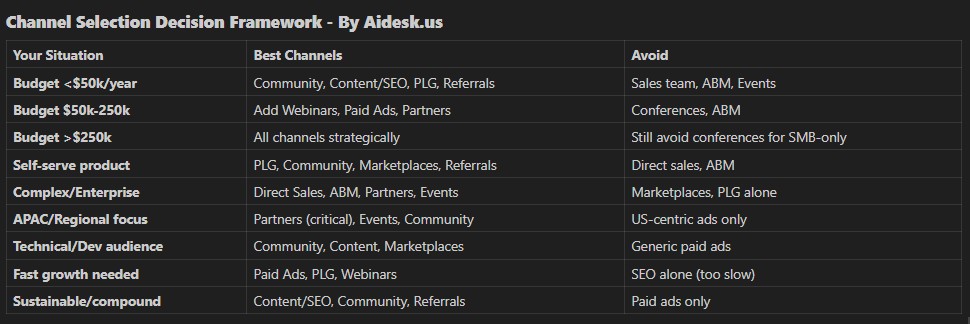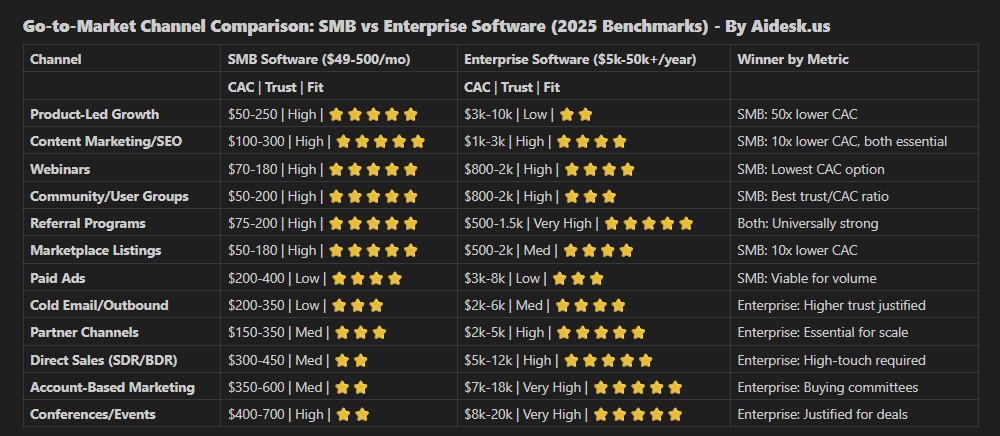Trying to ELI5 here. The key takeaway is that self-serve and enterprise software (can also be managed services or professional services) are two different wars. They have different CAC and deal sizes to begin with.
Self-serve is won by Community + Content + PLG + Webinars.
Enterprise service is won by Partners + Direct Sales + Referrals.
Of course, at the start you just have to try everything but you will quickly learn some patterns.
Using enterprise tactics for self-serve = broke.
Using self-serve tactics for enterprise = no sales.
Know what war you are in and use the right weapon for the right war.
Understanding the Two Different Wars
The fundamental mistake I see founders make is treating all GTM strategies as if they are equal. They are not. The battlefield for self-serve software is completely different from enterprise sales, and mixing up the tactics will drain your resources faster than anything else.
Self-Serve: The Volume Game
Self-serve software thrives on high volume, low touch, and rapid onboarding. Your customers discover you, sign up, and start using your product without ever talking to a human. This means:
- Lower CAC: You need to acquire customers cheaply because deal sizes are smaller
- Product-led growth: The product itself is your best salesperson
- Scale through automation: Everything needs to be self-service and repeatable
- Community-driven: Your users are your best marketers
Enterprise: The Relationship Game
Enterprise sales is about high-touch, relationship-building, and solving complex problems. Your customers need consultations, custom implementations, and ongoing support. This means:
- Higher CAC tolerance: You can afford expensive sales cycles because deal sizes are large
- Solution selling: You are selling transformation, not just a tool
- Trust and credibility: Decision-makers need confidence in your ability to deliver
- Long sales cycles: 3-12 months is normal, sometimes longer

The GTM Strategy Breakdown
Let me break down the most effective channels for each approach. This is based on patterns I have seen across hundreds of B2B software companies, and the data consistently shows these trends.
Self-Serve Winning Tactics
1. Community Building
Build a community around your product where users help each other, share use cases, and become advocates. Think Slack communities, Discord servers, or dedicated forums. Your community becomes your support team, your marketing team, and your product feedback loop.
- Host regular community calls
- Feature power users and success stories
- Create user-generated content programs
- Build public roadmaps with community voting
2. Content Marketing
Create educational content that attracts your target audience organically. This is not about selling, it is about teaching. Blog posts, tutorials, comparison guides, and how-to videos that rank well on Google and get shared on social media.
- SEO-optimized long-form content (2,500+ words)
- Tutorial videos and walkthroughs
- Comparison and alternative pages
- Free tools and calculators
3. Product-Led Growth (PLG)
Let your product do the selling. Offer a generous free tier or trial that lets users experience value before paying. Make onboarding frictionless, with in-app guidance and quick wins.
- Free tier with meaningful functionality
- Self-service onboarding with in-app tutorials
- Usage-based pricing that scales with value
- Viral loops and referral programs
4. Webinars and Online Events
Run educational webinars that teach a skill or solve a problem, with your product as the solution. These work because they are scalable, low-cost, and position you as an expert.
- Weekly educational webinars
- On-demand video library
- Partner with complementary tools for co-marketing
- Repurpose webinar content into blog posts and social media
Enterprise Winning Tactics
1. Strategic Partnerships
Build relationships with system integrators, consulting firms, and technology partners who can bring you into deals. Enterprise buyers trust their existing partners, so becoming part of that network is critical.
- Partner with consulting firms (McKinsey, Deloitte, Accenture)
- Technology partnerships (Salesforce, SAP, Microsoft)
- Reseller and referral agreements
- Co-selling programs with established vendors
2. Direct Sales Teams
Invest in experienced enterprise sales reps who know how to navigate complex organizations, build relationships with multiple stakeholders, and close six-figure deals. This is expensive but necessary.
- Account-based selling approach
- Multi-threaded sales strategy (engage multiple stakeholders)
- Custom demos and proof-of-concepts
- Executive sponsorship and C-level engagement
3. Referrals and Customer Success
Your best enterprise leads come from existing customers. Focus obsessively on customer success, case studies, and building a referenceable customer base. Enterprise buyers want to talk to peers who have successfully implemented your solution.
- Dedicated customer success teams
- Regular business reviews and QBRs
- Public case studies and testimonials
- Customer advisory boards
- Reference programs with incentives

The Most Common Mistakes
Mistake 1: Enterprise Tactics for Self-Serve Products
I have seen too many self-serve companies waste money on direct sales teams when they should be investing in content and product. If your deal size is $500/month, you cannot afford a sales rep spending weeks on each deal.
What happens:
- Sales reps get frustrated with small deal sizes
- CAC becomes unsustainable (spending $5,000 to acquire a $500 customer)
- Product development slows because resources go to sales
- Churn increases because customers do not need hand-holding
What to do instead:
- Build a better onboarding experience
- Create self-service resources (knowledge base, video tutorials)
- Invest in SEO and content marketing
- Offer a generous free trial or freemium model
Mistake 2: Self-Serve Tactics for Enterprise Products
On the flip side, enterprise companies trying to be "product-led" often fail because enterprise buyers do not want to self-serve. They want consultation, custom implementations, and ongoing support.
What happens:
- Enterprise buyers bounce from your website (no way to talk to sales)
- Your free trial does not convert (too complex to evaluate alone)
- You attract small customers who churn (not your target market)
- No one closes six-figure deals through a self-service checkout
What to do instead:
- Build a proper sales team with enterprise experience
- Offer consultative selling with custom demos
- Create case studies and proof points
- Invest in partnerships and channel sales
Finding Your Strategic Position
Here is how to figure out which war you are in:
Self-Serve Indicators
- Deal sizes under $10,000/year
- Simple implementation (hours to days)
- Broad target market (thousands of potential customers)
- Low-touch customer support needs
- Usage-based or seat-based pricing
Enterprise Indicators
- Deal sizes over $50,000/year
- Complex implementation (weeks to months)
- Narrow target market (hundreds of potential customers)
- High-touch customer success requirements
- Custom pricing and contracts
Hybrid Models (Most Challenging)
- Start with one clear segment, nail it, then expand
- Use self-serve to generate enterprise leads (land and expand)
- Offer different product tiers for different segments
- Build separate go-to-market teams for each segment
The AI Desk Approach: Self-Serve with Managed Services
At AI Desk, we have learned this lesson the hard way. We started as a pure self-serve product-sign up, integrate, and go live in 10 minutes. That worked great for small businesses and agencies that wanted to move fast.
But we quickly realized enterprise customers needed something different. They wanted:
- Consultation on their specific support workflows
- Custom AI training on their documentation
- Integration with complex systems (Salesforce, SAP, custom CRMs)
- Ongoing optimization and management
So we built a dual GTM strategy:
Self-Serve Track ($49-299/month):
- Community support via Discord and documentation
- Educational content (blog posts, tutorials, webinars)
- Product-led onboarding with in-app guidance
- Self-service knowledge base management
Managed Services Track (Custom pricing):
- Direct sales team with enterprise experience
- Strategic partnerships with agencies and consultancies
- Custom implementations and integrations
- Dedicated customer success managers
This approach works because we are clear about which customers fit which track, and we do not try to force square pegs into round holes.
Practical Implementation Framework
For Self-Serve Companies
Month 1-3: Foundation
- Set up content marketing engine (blog, SEO strategy)
- Build community channels (Slack/Discord)
- Create self-service onboarding flow
- Launch freemium or generous trial
Month 4-6: Growth
- Publish 2-3 high-quality blog posts per week
- Run weekly educational webinars
- Build referral program
- Optimize product activation metrics
Month 7-12: Scale
- Expand content to video and podcasts
- Launch integration marketplace
- Create user certification program
- Develop viral growth loops
For Enterprise Companies
Month 1-3: Foundation
- Hire experienced enterprise sales team
- Build case studies from beta customers
- Identify strategic partnership opportunities
- Create sales enablement materials
Month 4-6: Pipeline
- Launch account-based marketing campaigns
- Establish partner referral programs
- Run executive dinner events
- Build custom demo environments
Month 7-12: Scale
- Expand sales team based on metrics
- Deepen strategic partnerships
- Launch customer advisory board
- Develop reference program
Key Metrics to Track
Self-Serve Metrics
- Product Qualified Leads (PQLs)
- Time to first value
- Activation rate (% of signups that complete onboarding)
- Organic traffic growth
- Community engagement (DAU/MAU)
- Net Revenue Retention (NRR)
Enterprise Metrics
- Sales pipeline coverage (3-5x your quarterly target)
- Average deal size
- Sales cycle length
- Win rate by segment
- Customer Acquisition Cost (CAC) by channel
- Customer Lifetime Value (LTV)
The Strategic Takeaway
The most important lesson is this: clarity beats complexity. Do not try to be everything to everyone. Pick your battlefield-self-serve or enterprise - and master the tactics that work for that specific war.
If you are building a self-serve product, go all-in on community, content, PLG, and webinars. If you are building an enterprise solution, invest in partnerships, direct sales, and customer success.
At AI Desk, we are primarily self-serve with instant deployment, but we also welcome partner leads for customers who need professional implementation. This hybrid approach works because we know our primary battlefield is self-serve, but we stay open to enterprise opportunities that come through trusted partners.
Know what war you are in. Use the right weapon. Win the right battles.